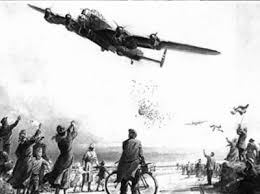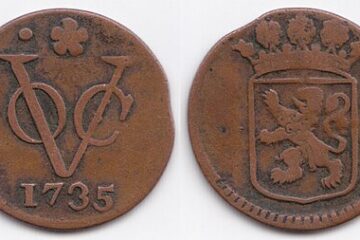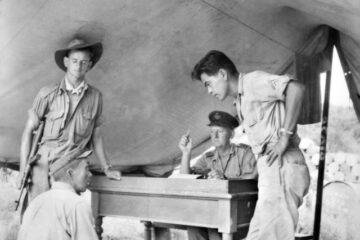During the final months of World War II, the Australian 460 Lancaster Squadron played a pivotal role in Operation Manna, a humanitarian mission that delivered desperately needed food to the starving people of the Netherlands.

During the harsh winter of 1944-1945 the Dutch population endured a major famine. Known as the ‘hungerwinter’ it was concentrated in the densely populated urban areas bounded by Amsterdam, Utrecht, Rotterdam and The Hague. By 1945 the daily ration had been reduced to 600 calories – a third of what it had been in 1941.

The squadron flew 118 Lancaster sorties. Over 340,000 kilograms of food in total was dropped over the Netherlands by 460 Squadron alone, which would have been enough to feed 400,000 people for one day.
The crews’ compassionate efforts extended beyond their official duties, as many donated personal items such as cigarettes and chocolates, crafting makeshift parachutes to drop these gifts from their aircraft.
The Operation
The food drop operation required meticulous planning and brave execution. As described by Keith Chamberlain, who participated in three drops, loading the Lancasters was a physically demanding task. Due to the hydraulic mechanism of the bomb doors, they had to be propped partially closed with wooden poles while crew members manually stowed the food inside the bomb bay. Only once the engines were started could the doors be fully closed for take-off.

The official drop altitude was 150 meters, though many crews flew even lower, risking being struck by their own dropped supplies. The sight of jubilant, starving crowds waving at the planes was deeply moving, often bringing tears to the eyes of the airmen.
The final Manna run by 460 Squadron, on 7 May 1945 was also the largest for the squadron, with twenty eight aircraft taking part. With the end of the war in Europe on 8 May, Operation Manna concluded. Further food supplies were brought in by land. Although the situation in the Netherlands was still extremely difficult, Operation Manna provided a major morale boost for the occupied nation.
Official Report and Personal Accounts

The 460 Squadron’s official report on the Manna drops highlighted the challenging weather conditions and the precision required to hit the designated aiming points, marked by white crosses with red lights. Despite occasional mishaps, such as bags landing in water, the food was delivered successfully, and all aircraft returned safely.
Personal accounts from the crew members bring the operation to life. Art Whitmarsh’s visits to the Netherlands for Manna Day celebrations underscore the enduring gratitude of the Dutch people, who hold annual commemorations akin to Anzac Day. Frank Lawrence, a veteran of both 460 and 467 Squadrons, described the profound emotional impact of participating in Operation Manna, calling it the most rewarding experience of his war service.
Enduring Legacy
The impact of Operation Manna extended beyond the immediate relief it provided. The Dutch people continue to honour the efforts of the 460 Squadron, teaching the story in schools and celebrating it with annual events. Letters of gratitude, like the one from Jan C. Van Vliet’s father, express profound thanks for the lifesaving efforts of the Australian airmen.
Conclusion
Operation Manna stands as a testament to the compassion and bravery of the 460 Squadron. Their efforts not only saved countless lives but also forged a lasting bond between Australia and the Netherlands. The mission’s legacy is a powerful reminder of humanity’s capacity for kindness, even amidst the horrors of war.
Source: 460 Squadron Manna Operation
See also: Food from Heaven – 460 Squadron and Operation Manna, 1945


